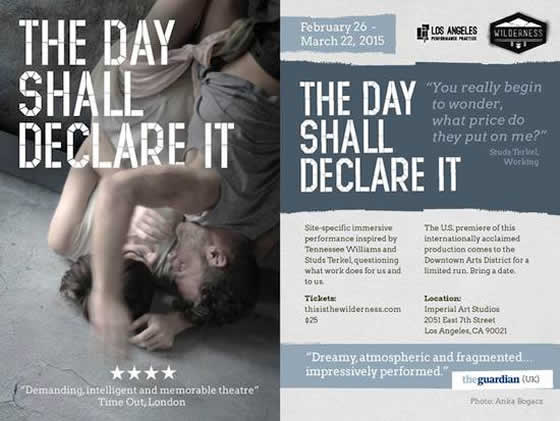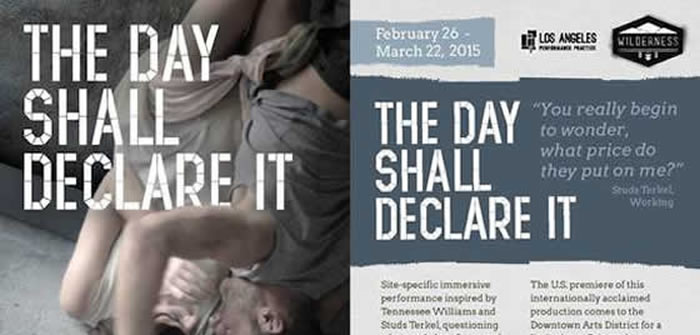 ‘”The Day Shall Declare It”. Call me spoiled, but in my day theatre was about big ideas, philosophical, political and ethical ideas, and in the hands of the best playwrights, it offered poetic language, For the last few decades, theatre seems to veer between sitcoms scripts and pretentious post modern mash-ups. My problem with many dramaturge driven postmodern pieces is the lack of context; now more than ever we need history lessons and social context. Taken out of context, ideas lose their bite, actions loose their consequences, dramas lose their ability to move us through identification, and theatre loses its edge to morally instruct. What ever happened to catharsis?
‘”The Day Shall Declare It”. Call me spoiled, but in my day theatre was about big ideas, philosophical, political and ethical ideas, and in the hands of the best playwrights, it offered poetic language, For the last few decades, theatre seems to veer between sitcoms scripts and pretentious post modern mash-ups. My problem with many dramaturge driven postmodern pieces is the lack of context; now more than ever we need history lessons and social context. Taken out of context, ideas lose their bite, actions loose their consequences, dramas lose their ability to move us through identification, and theatre loses its edge to morally instruct. What ever happened to catharsis?
During periods of governmental repression, oppression and conformity, playwrights used allegory to address urgent political and moral issues, hiding a topic (most famously “The Crucible’ Arthur Miller’s play about the McCarthy Hearings told through the Salem Witch Trials.)
Now stories and lessons as are lost between clever stagings and kitsch cultural quotes taken out of context.
I say this because ‘The Day Shall Declare It”, while filled with modern ideas of staging, is anything but pretentious, and takes on big ideas with language that sings and actors that dance.
Conceived by LA/ London based Annie Saunders, created by the international interdisciplinary Wilderness, Directed by choreographer/ director Sophie Bortolussi and Annie Saunders.
‘We need the tonic of wilderness…we require that all things be mysterious and unexplorable, and indefinitely wild, unsurveyed and unfathomed by us because unfathomable.’ Thoreau
Wilderness works internationally to push the envelope of the traditional theatre-going experience. Inspired by disused, unexplored and uninhabited spaces, we create immersive, experiential and interdisciplinary theatrical events that disrupt the boundaries between observer and observed. Audiences roam freely throughout our curated environments, performers weave in and out of rooms, and multiple storylines tempt participants one way and another to create a unique choose-your-own-adventure experience.” Wilderness mission statement.
Annie Saunders explained that she was looking for a way to address the issues of work and unemployment and its effect on relationships.
She turned to texts from the Great Depression, staged in a modern Physical Theatre site -specific staging to bring the message home to a modern audience. Passages from Studs Turkel’s “Working”, a vivid series of interviews with working people from all facets of American Life, and early plays and short stories of Tennessee Williams carry us through three relationships. I recognized “Moony’s Kid Don’t Cry” and “Talk to Me Like the Rain and Let Me Listen…” “Summer by the Lake”, “Ten Blocks on the Camino Real” and the short story “One Arm.” Other texts woven include “The Fat Man’s Wife”, “Curtains for the Gentleman”, “Not About Nightingales” “The Man in the Overstuffed Chair” and many extracts of interviews from Studs Terkel’s landmark book “Working”.
The piece is described in the program described as “immersive, site-responsive theater installation that explores the concept of work: both what it means to us and what it does to us. The piece interrogates beliefs about working, work ethics, work/life balance and how these concepts infiltrate our relationships with others and ourselves.”
The three-person show is compelling, carnal and resonant with those big ideas I’ve been missing. The play was originally mounted in London, in 2014. Two of the cast members, Saunders and British actor Chris Polick reprise their roles, joined by LA actor Nick Konow.
They are all powerful performers and wonderful to watch.
All the actors have been coached to perform a very physical form of movement, reminiscent of contact improv. Fights, seductions, love scenes, all shown in tensile couplings as one performer rides anther’s body. In one signature movement, an actor carries another curled around his/ her waist. In The apartment scene, MAN WHO circles their dining room table, HER draped around his waits, dusting the table as they circle. In The final sequence a bathtub is the third character, tipped, dragged or used as a jungle gym, it is both barrier and refuge to the couple.
The play is a series of pas-de deux.
The play begins around us. A working bar lures audience members to buy a drink. Three characters emerge among the audience; the bartender (Nick Konow), a dish in a red silk halter dress Woman (Annie Saunders) and besuited smooth talker Man (Chris Polick) who waltzes her around the floor. The next sequence which moves through several open plan spaces, trailed by curious audience members, is their flat. The house-robed woman cleans as the Man in, his undershirt, rails at life and dream his big dreams. He’s chronically at trouble at the plant. She tells him his coworkers make fun of him. They argue, their relationship is on the skids; he’s bringing no money home, and talking big.
The argumentative Man (spouting his dreams of freedom) prowls around his wife, literally scaling the furniture, crossing the room climbing from one shelf to another.
The middle sequence, a two-man fight cum seduction is muscular and threatening. They grapple, fight and signal an almost subliminal flirtation. A strobe effect sequence mirrors recent Occupy images. A beach setting is the dissolution of a second male female couple. Here, the woman is the dreamer, dreaming of changing her name and disappearing to a quiet life by the sea. to living and dying among strangers.
Wilderness’s Physical Theatre deploys post modern and Contact Improvisation dance strategies: like Lucinda Childs, choreographer Sophie Bortolussi sometimes builds shapes with bodies and props.
Casual movements, bursts of energy and collapses, bodies in contact and shared weight, repetitions as the performers trade off weight bearing, alternating from active to passive movements, they move together creating multi-limbed shapes in space. What’s not used in Bortolussi’s choreography is Tharp’s showier glides and percussive syncopations.
If anything, I was reminded of Mangrove and David Gordon’s early performances, which laced physical movement with political references.
Postmodernist Dance, which emerged in the 60’s owes is exploration in part to Merce Cunningham’s landmark theories. It was a rejection of Modern Dance conventions, as Modern Dance rejected Ballet techniques.
By rejecting many traditional dance techniques, and virtuoso solos, Postmodernism democratized the process of dance. It favored an open vocabulary of movement drawn from daily life. The body itself, and its response to gravity, became the theatrical gesture. Originally Postmodernism rejected creating a vocabulary or style but over decades a style emerge: falls, collisions, leaps, spiraling, touch and weight, rise and fall, repetitions and reversals, surging and falling back and casual forms of carrying the partners body, these are the building blocks.
Wilderness is a group to watch and this is MUST SEE entertainment.
The LA production is produced by Rachel Sandling and Miranda Wright of Los Angeles performance practice.
Los Angeles Performance Practice & Wilderness Present
The U.S. Premiere of The Day Shall Declare It
An Immersive, Physical Theatre Installation
Exploring the Concept of Work
At Imperial Arts Studios in Downtown Los Angeles
Thursday, February 26 to Sunday, March 22, 2015
CAPACITY IS LIMITED. WE STRONGLY ENCOURAGE YOU TO BOOK IN ADVANCE.
This performance is standing room only. We recommend wearing comfortable shoes and avoiding carrying heavy bags. The performance runs approximately 90 minutes.
Imperial Art Studios
2051 East 7th Street Los Angeles CA 90021
For tickets go to http://losangelesperformancepractice.org/current-work/the-day-shall-declare-it/

